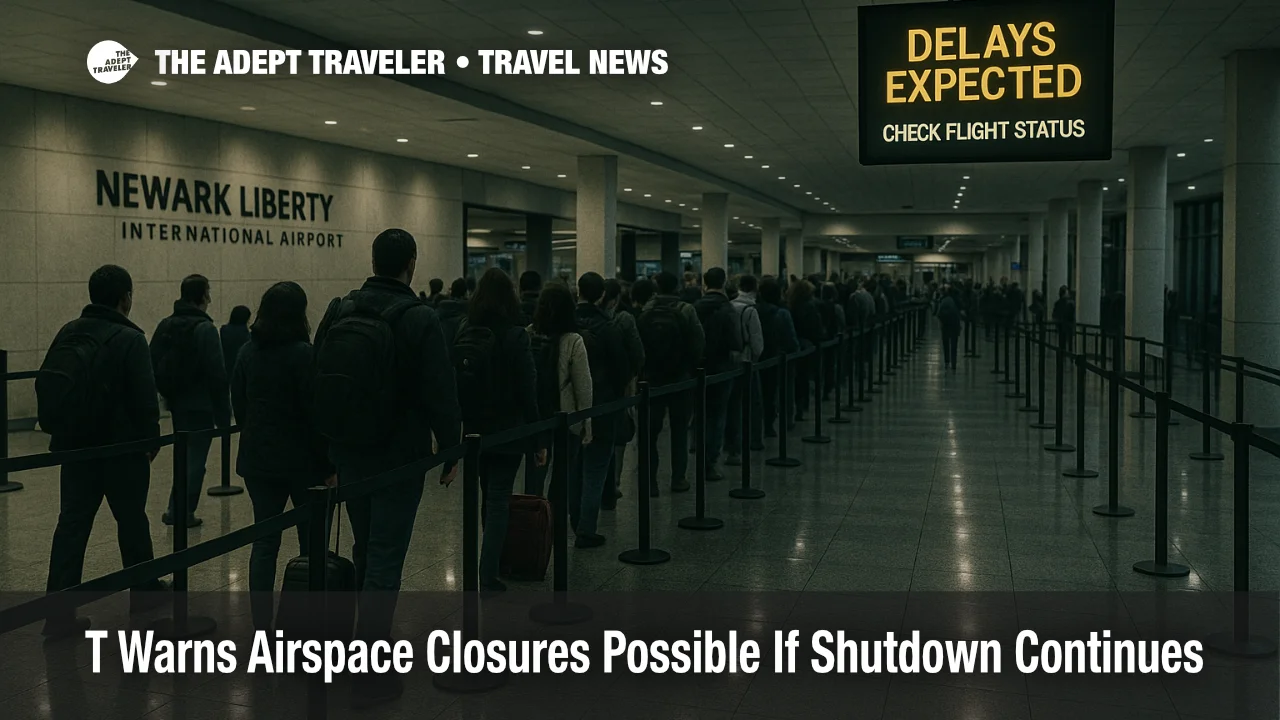DOT Warns Airspace Closures Possible If Shutdown Continues

Key points
- DOT says portions of U.S. airspace could close next week if the shutdown continues
- FAA reports nearly 50% of major ATC facilities face staffing shortages and 13,000 controllers are unpaid
- Newark saw a ground stop Sunday due to staffing, highlighting growing operational risk
- Duffy walked back earlier comments about firing controllers, emphasizing support and safety
- Travelers should expect rolling delays, pop up ground stops, and potential schedule cuts
Impact
- Expect Rolling Disruptions
- Prepare for day of delays, longer TSA lines, and sporadic ground stops at busy hubs
- Pad Connections
- Add 60-90 minutes for interline and international transfers through major hubs
- Monitor Airline Waivers
- Check carrier travel alerts for fee free changes if your route shows ATC constraints
- Use Earlier Flights
- When possible move to earlier banks that are less exposed to afternoon traffic compression
- Watch New York Area
- EWR, JFK, and LaGuardia are higher risk while ATC staffing remains constrained
Transportation Secretary Sean Duffy warned on November 4 that the Department of Transportation may be forced to close portions of U.S. airspace as soon as next week if the federal government shutdown continues, elevating what has been a surge of delays into a potential capacity crisis. He said mass delays and cancellations would be used to keep operations safe if air traffic control, ATC, staffing cannot support normal traffic levels. The comments follow a weekend in which Newark Liberty International Airport experienced a ground stop tied to staffing, a visible sign of strain that travelers felt across several hubs.
What changed and why it matters
Duffy's warning moves the conversation from delays to possible airspace restrictions, a rare step generally reserved for severe weather or safety exigencies. The Federal Aviation Administration, FAA, says nearly half of its major facilities are dealing with staffing shortages, while approximately 13,000 controllers are working without pay because of the shutdown that began October 1. That combination has produced heavy absenteeism spikes in key regions, including the New York area, and introduces operational risk when facilities are thin on certified controllers.
Latest developments
On Sunday, the FAA briefly halted departures bound for Newark, underscoring how quickly staffing gaps can force traffic management initiatives. City officials also warned that extended delays or a broader ground stop were possible if staffing deteriorated further. The ripple effects reached other Northeast airports and major hubs as flow constraints and miles-in-trail programs compressed capacity.
Duffy, who said on October 9 that controllers who do not report could be let go, moderated that stance during interviews this past weekend, stating he would not fire controllers amid the shutdown and emphasizing that safety will drive decisions, even if that means delaying or canceling large numbers of flights.
Background
Air traffic controllers are designated essential, so they must work during a lapse in appropriations, but they do so without pay until Congress funds the government. Extended unpaid periods increase sick calls and fatigue concerns, particularly in high-complexity facilities, which amplifies delay programs, reroutes, and, in extreme cases, ground stops. When multiple facilities in a region are thin at once, the FAA may meter traffic heavily or limit operations, which is why Duffy's comments about closing parts of the airspace, if needed, are significant.
Analysis
Travelers should expect volatility through at least the next week. The pattern to watch is late-morning through evening compression at major hubs, especially in the New York area where staffing spikes have been acute. If the shutdown persists, carriers are likely to trim peak-bank schedules, swap to smaller banks with longer turns, and extend block times, all of which reduce missed-connection risk but shrink same-day rebooking options. For transatlantic and transcon flyers, the safest strategy is to move to earlier departures and avoid tight connections at known pinch points.
For now, safety remains the priority. Duffy signaled that DOT and FAA will proactively slow the system rather than run facilities beyond safe staffing thresholds. That means more days with rolling ground delay programs, occasional ground stops, and, in a worst-case scenario, temporary regional airspace restrictions until staffing stabilizes or funding resumes.
Final thoughts
The primary risk has shifted from isolated delays to potential capacity reductions if the shutdown extends. Travelers should act conservatively with connection buffers and monitor airline alerts closely. If DOT proceeds with targeted airspace closures, the impact will concentrate in the busiest corridors first, notably the New York region, and then propagate nationwide via aircraft and crew rotations. Keeping plans flexible over the next seven to ten days will reduce stress while the system operates under constraint.
Sources
- Department of Transportation might be forced to shut down some airspace next week: Duffy
- Video, DOT might be forced to shut down some airspace next week
- Staffing issues trigger ground stop at Newark Liberty International Airport on Sunday
- Sean Duffy says airport delays will continue as shutdown drags on
- FAA says nearly half of major air traffic control facilities are experiencing staffing shortages
- Transportation Secretary Sean Duffy says airport delays will 'get worse' as shutdown rumbles on
- NYC warns of hourslong delays at Newark over staffing shortages, says a full ground stoppage is possible
